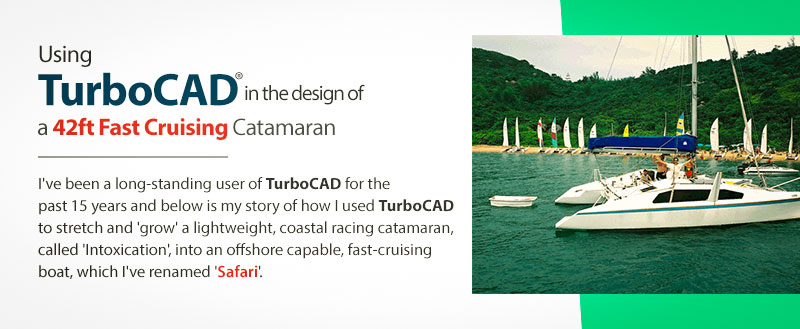Using TurboCAD® in the design of ‘Safari’, a 42ft fast cruising catamaran
Published : 02/25/2021 12:41:25
Using TurboCAD® in the design of ‘Safari’, a 42ft fast cruising catamaran.
Marcus Tomblin
Safari, cruising in the Visayas, Philippines in 2018
I started out with a 34ftx22ft 2600kg (open bridgedeck) lightweight coastal racing catamaran called “Intoxication” which I wanted to stretch, and ‘grow’ into an (offshore capable) fast cruising catamaran.
Essentially I used the bow and stern shapes of the old catamaran, cut and extended and built into a new much bigger and stronger shell, the new “Safari” now 42ftx22ft and 4500kg.
Original catamaran ‘Intoxication’.
The original boat was then carefully measured and entered into TurboCAD by Mike Allen, my boat builder, and the owner of Boatshop Philippines. He introduced me to the TurboCAD software that he was already using in his business, designing and building over 20 mono and multi-hulls by then. I had previously used AutoCAD® for three years in engineering design related work at Bristol University, UK, where I graduated as an Aeronautical Engineer.
What followed in the next 3 years of the build was an easy back and forth design iteration of the initial boat using TurboCAD, as I developed the design, and Mike Allen added his comments and suggestions, and as we made changes as the build work proceeded, and the plans were continually updated and improved.
The cabin headroom and ergonomics were carefully experimented with in TurboCAD, again with my “model man”, sitting up and standing. Similarly to optimize the winch and steering wheel positions for comfortable use and correct sight-lines to the 4 corners of the boat, and a good view of the rig when sailing, both seated and standing, my “model man” came in very handy, being able to set his reach and eye and hand heights, and play around with the design before building anything were invaluable.
With the completed boat shell, the deck plan and equipment layout was easy to superimpose on more layers in TurboCAD, I mentioned that the deck equipment ergonomics were easy to plan properly using/moving my “model man” around in TurboCAD before building the equipment into the boat, saving a lot of time and experimentation.
For the mast and rig, I managed to find a slightly damaged and discarded (insurance claim) 21m carbon mast tube from a newly delivered 43ft racing monohull, and along with Hallspars NZ (the mast manufacturer), modified it for multihull application.
Again using a carefully measured model of the mast in TurboCAD, I shortened it to 16m removing 2m at the center join, and 3m off the bottom of the mast tube, keeping the diamond spreaders in the correct relative positions. Hallspars provided the fittings, spreaders and standing rigging to rebuild it into a high performance catamaran rig, shorter and much stronger (as catamarans don’t heel and unload their sails/rig in gusts).
Safari racing in Hong Kong with her new Hallspars carbon mast and Hydranet sails:
I have a new home and several pool villas to design and build next on TurboCAD, and a new sail catamaran “Safari 2” is already in the design process, a 37ft version of Safari with a “mast aft” rig and “galley up”, the smaller size being desirable and easier to handle for (just two) older people cruising.
A big thanks to IMSI design and their TurboCAD software that has helped me in the design and build of Safari over these past years.
The new ‘Safari 2’, a 37ft rig-aft design.









